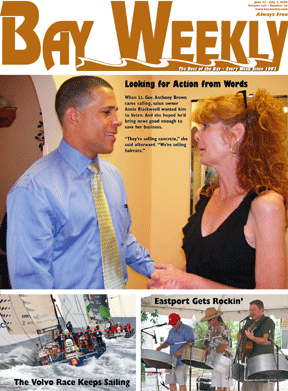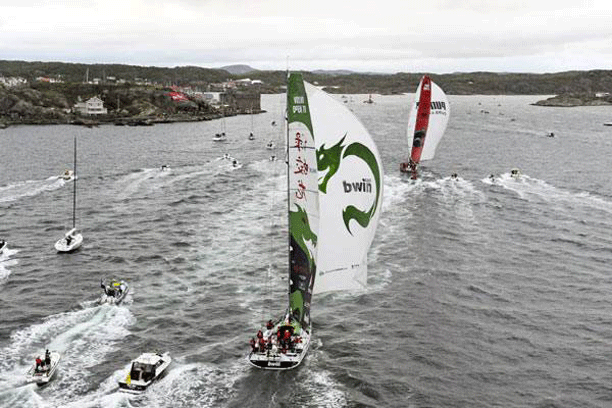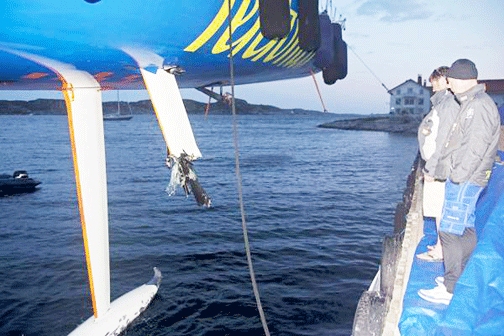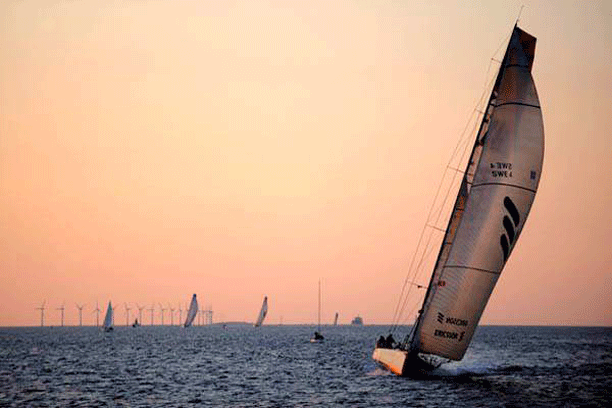
Volume XVII, Issue 26 # June 25 - July 1, 2009 |
 |
Nearly ’round the World
It’s down to the short legs for the Volvo Ocean Race
by Steve Carr
Leg 8: 1,250 miles, Galway to Marstrand
 |
| Wrapping up the eighth of nine legs, PUMA finishes in second place, with Green Dragon close behind in third. |
The Volvo boats left Galway on the 65th anniversary of D-Day after a raucous two-week stopover on the Emerald Isle. The consensus was that Galway was the best stop yet, starting with the 8,000 spectators who emptied the bars on a Saturday night at 3am to welcome the winner, Ericsson 4. Over 500 boats lined the harbor in the rain.
The national tourism board estimated that 420,000 visited the Race Village during the stop, pumping well over 50 million euros into the local economy. Take note, Maryland!
Green Dragon skipper Ian Walker heaped on praise: “When I saw the welcome we received on arriving in Galway, I was speechless but when we left two weeks later it was with tears in my eyes.”
Inshore or the
Open Sea?
The 1,250-mile leg to Marstrand, Sweden began with a torrid downwind drag race in 20-knot winds. The boats gybed their way down the Irish coast amidst squalls galore.
Ericsson 4, which has consistently performed the best in these heavy downwind conditions, breezed past the Aran Islands in first place followed closely by PUMA in second. Once past Fastnet Rock, it was adios to Ireland and into the tricky English Channel.
The tactical choice this leg was whether to stay inshore or get out into the open sea. Storm cells and constantly shifting winds made navigation a crapshoot. Positions on the leader board changed every four hours as the boats sailed within sight of one another.
Adding to the tension, narrowing the course and limiting the options were two exclusion zones to keep the racers away from the busy shipping channels into London and Rotterdam.
Then there was the current. The currents between France and England funnel water like a fire hose and at a steady six knots. When the wind drops out, they can stop you in your tracks and push you back, as they did several boats during a foul tide on the evening of Day 2. The granddaddy of all currents comes off the Cherbourg Peninsula, which juts out from France.
The choice was to stay in shallow water and deal with less tide, or get out into the middle of the English Channel where the tide is weaker.
Coastal hugging was the right choice for Telefonica Black, which went from 25 miles back in last to first place. Green Dragon followed. Boats closer to the Cornish Coast found winds sketchy and going upwind.
Eventually, the tide switched, and the wind off of England increased. The fleet came together just past the Channel Islands as they readied for the next battle in the Dover Strait.
Weather forecasting in this part of the world is like reading tea leaves. As the boats sailed upwind through the Dover Strait, a low-pressure system appeared out of nowhere. The wind shifted from northeast to the south. E4 caught it first and took off like a rocket back into first place.
Meanwhile, PUMA’s spinnaker exploded and they drifted to the back of the pack, racing in full-on, smash-mouth choppy seas and a 30-knot westerly off the northern tip of Holland.
That unpredictable low-pressure system wasn’t finished with the fleet. PUMA escaped from its dead-wind grip to head northwest into the choppy, bone-rattling North Sea and over the top of the storm. Leaders E4 and Green Dragon hugged the Frisian Islands and the rocky beaches of Denmark. As the beach boats struggled north in fluky winds, PUMA found fresh wind and blasted east.
In the final battle, the first six boats merged in the Skagerrak Strait, which connects the North Sea to the Baltic between Denmark, Norway and Sweden. Ericsson 4 held on to win its third straight Leg, followed seven minutes later by the big cat PUMA, then the Chinese/Irish Green Dragon.
Leg 9: 525 Miles, Marstrand to Stockholm
The Volvo Ocean Race’s shortest leg began with disaster. On a beautiful sunny day, the spectator fleet lined Marstrand Harbor as the seven still-racing Volvo 70s unleashed their power in ideal racing conditions, with winds gusting to 17 knots.
 |
| Telefonica Blue is lifted out of the water, revealing the extent of damage sustained after running aground for the second time. |
Telefonica Blue started shaky, then headed up the right side of the course into a 120-degree wind shift, launching into first place, PUMA tailing.
Then — just as at the start of Leg 5, leaving Qingdao, China — T-Blue ran aground. A granite rock nearly sank the boat.
It took the Coast Guard two hours to get the blue boat off the rock while the crew struggled to keep their ship from sinking. The port daggerboard had been sheered off, and the surrounding casing smashed. They were taking on lots of water. Pumps and hand bailing kept her afloat, but waves continued to rip the boat apart.
Meanwhile, the Ericsson twins and Green Dragon led the southern charge along the Swedish coast, followed by many spectator boats.
Heading into the Kattegat Strait — a passage between Sweden and Denmark so narrow and treacherous with rocky shoals and shallow spots that medieval ship captains said you could barely squeeze a cat through safely — PUMA took the lead entering the wider but no less tricky Oresund Sound.
The wind remained strong as the Volvo 70s powered along at 20 knots. The Ericsson twins continued to dog PUMA going west of Saltholm Island and over the tunnel rather than under the world-famous bridge connecting Copenhagen and Malmö.
Closer and Closer

![]() Rounding Sandhammaren at the southern tip of Sweden, with about 250 miles to go, PUMA was still sandwiched between the Ericsson twins. A few miles behind, Delta Lloyd, Green Dragon and Telefonica Black were virtually sailing alongside one another.
Rounding Sandhammaren at the southern tip of Sweden, with about 250 miles to go, PUMA was still sandwiched between the Ericsson twins. A few miles behind, Delta Lloyd, Green Dragon and Telefonica Black were virtually sailing alongside one another.
As the lead boats reached Landsort in the southern part of the archipelago of Stockholm, the wind petered down to about seven knots. Weather models showed 20 to 25 knots of breeze just beyond. PUMA and the Ericsson boats continued to steer clear of the coast. Meanwhile, the trailing pack were sailing in stronger winds and closing the gap.
With 122 miles to go, the fleet tacked up the coast of Gotland in a strengthening breeze. PUMA, still looking to win a first ocean leg, inched into the lead with Ericsson 3 only a quarter-mile behind.
With a scant eight miles to go, the wind dropped out again as PUMA and E3 began a fierce tacking duel around the Revengegrundet and Svangen lighthouses.
With three miles to go, Ken Read, the skipper of PUMA, made the biggest mistake of match racing by letting E3 tack away. When the boats came back together, E3 was in the lead by about three lengths.
A tacking duel in Volvo 70s is like turning around an aircraft carrier with sails. When E3 wrapped the headsail around the radar, PUMA took advantage and rolled them with a mile to go.
Ken Read wasn’t going to make the same mistake twice and covered E3 like a blanket, maintaining a four-length lead to take the race by a little over a minute. E4 finished third 14 minutes later.
With one in-port race and the final leg to St. Petersburg, Ericsson 4 has clinched the 2009 Volvo Ocean Race. In the fight for second, Telefonica Blue is only nine points behind PUMA. But after running aground twice, T-Blue has something to prove.